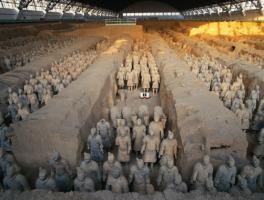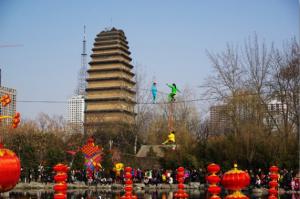Join-in Group Silk Road China Tours
About Us | Contact us | Tourist Map | Hotels | Feedback
Xian Attractions

Overview:Located on the east side (about 1.5 km) of the Chin Shi Huang's mausoleum (aka the Tomb of Qin Shihuang), the site is now the world famous Terracotta Warriors and Horse Museum, which collects about 8,000 life-size pottery warriors, 130 chariots with 520 horses and 150 cavalry horses.
Terracotta Warriors and Horses also called Terracotta Army or Chin's Armies (Qin's Armies) by the tourists. They are actually the figures buried with the Emperor of Chin Shi Huang (259-210 B.C, the first emperor of China, his reign ruled over Chin was from 247-221BC and unified China from 221 BC to the end of his life in 210 BC). Presumably the terracotta warriors represent the army which is meant to protect the necropolis and assist the emperor to rule another empire in his afterlife.
In 1974 peasants digging a well about 1500 meters east of the tomb uncovered an underground vault of earth and timber and subsequent excavation revealed thousands of terracotta figures, life-size warriors and their horses all in battle formation - a whole army which would follow its emperor into immortality! In 1976, two other vaults were discovered close to the first one. The first and largest pit has been covered over with a roof to become a huge archaeological exhibition hall.
The underground vault measures 210 meters east to west and 62 meters from north to south. The bottom of the pit varies from five to seven meters below ground level; walls were built running from east to west at intervals of the three meters, forming corridors laid with grey brick, are arrayed the terracotta figures, and pillars and beams support of a roof.
Buried in the vault were a total of 6000 life-size terracotta figures of soldiers and horses in a practical battle formation. The figures all face east and form a rectangular battle array. The vanguard appears to be three rows of 210 crossbow and long bowmen who stand at the easternmost end of the army. Close behind is the main force of armored soldiers, holding bronze spears, crossbows, arrows, lances, dagger-axes, halberds, Pi, Shu, swords, scimitars and other long-shaft weapons, and these soldiers are intermingled with 35 horse-drawn chariots.
The terracotta figures vary in height (184-197cm) and each differs in appearance, facial features, and expressions, studies show that they belong to different ethnic groups of ancient China. The figures of the horsemen show them wearing tight-sleeved outer robes, short coats of chain mail and wind-proof caps. The archers are sculptured with their bodies and limbs positioned in strict accordance with an ancient book on the art of war. According to their hairstyles and dresses we can judge their roles they can be classified into the generals, warriors, officials, acrobats, strongmen, and musicians.
Many of the figures originally held real weapons of the day and over 10,000 pieces have been sorted out of date. Bronze swords were worn by the figures representing the generals and other senior officers; surface treatment made the swords resistant to rust and corrosion so that after being hurried for more than 2000 years they were still sharp. Arrow-heads were made of a metal alloy containing a high percentage of lead, making them highly lethal.
Vault 2, excavated in 1976, contains over 1,300 terracotta figures, which are specialized military forces, including archers, chariots, cavalries and thousands upon thousands of bronze weapons. The battle formations in this pit are more grandiose and complicated than those in the Pit 1 for its diverse armed branches. Here you can see the special figures such as the knights, the standing archers, and the kneeling archers.
Vault 3 is the smallest of the three, covers an area of 520 square meters, containing only 68 soldiers, four horses and one chariot and appears to be the command post for soldiers in the other Pits.
In fact, apart from the above three mentions, there is still a vault which occupies an area of 4,000 square meters. It is empty and rarely mentioned, seemingly left unfinished by its builders in the museum.
The Terracotta Army was put on the list of the World Cultural Heritage by the UNESCO as a miraculous archeological discovery in 1987. It has enjoyed the reputation of the "world's eighth wonder" since it was dug up. Anyone who visits Xi'an would not miss this grandiose and stunning legion of the Chin dynasty.


